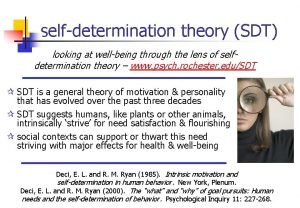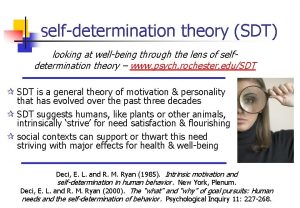SelfDetermination Theory SDT has grown out of the



- Slides: 3

*Self-Determination Theory (SDT) has grown out of the research on motivation performed by Richard M. Ryan and Edward L. Deci both of the University of Rochester (Ryan and Deci, 2000 a). * SDT establishes three internal needs that we seek to satisfy: competence, relatedness and autonomy. * SDT considers both internal and external motivation (Ryan and Deci, 2000). *

* We are intrinsically motivated to satisfy our needs of competence, relatedness and autonomy. * Extrinsic factors can have positive or negative effects on our intrinsic motivation based on the effect the extrinsic factors have on these needs (Deci, Koestner & Ryan, 2001). * Verbal rewards (“positive feedback”) can increase a student’s sense of competence * Tangible rewards such as grades or prizes can decrease a student’s sense of autonomy (control over their work) and have a negative impact on motivation. *

* Students wish to fulfill three primary needs. When instructional design leads to activities that fulfill these needs then learning can be more successful. * Competence * Students will be intrinsically motivated to perform if they feel they are competent and understand the material at hand. * This is best illustrated by the proper scaffolding of lessons so that students can master tasks and feel successful before moving on to more difficult work. (Dirksen, 2012) * Relatedness * Student engagement is enhanced when the instructional material covered has direct relevance to them (Deci, 2009) * Autonomy * Student success can be improved when activities allow students a sense of choice and control over the purpose and outcome of their education (Deci, 2009; Cavendish, 2013). *




